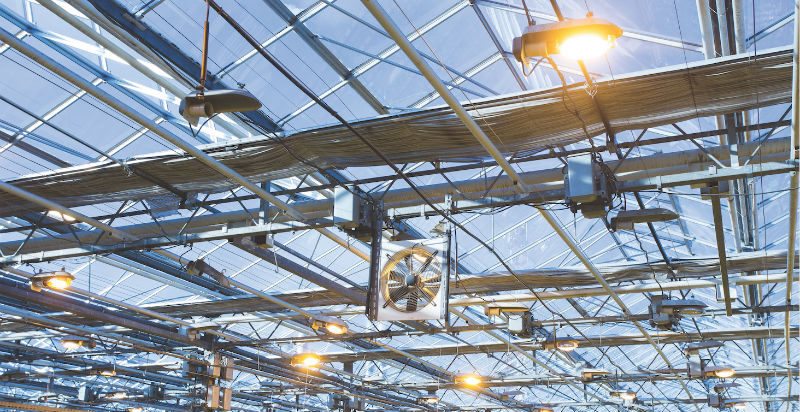
Lighting Plans: Their Generation and Importance
Whether for a commercial greenhouse or an indoor growing facility, light intensity and uniformity are critical to successful production of plants. Light sources should be positioned based on several parameters including their output characteristics and the dimensions of the growing area. Light sources vary considerably in their light output, including the intensity and spectrum of the light, and how that light is distributed to plants below. This article describes how lighting plans are developed and why they are so important when comparing lighting technologies.
Fixture manufacturers have capabilities to create a light layout using software that utilizes IES (Illuminating Engineering Society) data files. Each lamp type and reflector has a unique IES file. This file is typically generated by using a goniophotometer, which is a mechanical device that measures luminous intensity at each angle, at a set distance. Data are in candelas, which is the total amount of light emitted from a lamp in units of lumens (lm) per steradian (sr), or lm·sr–¹. However, these units are only appropriate for human lighting and different files need to be used for plant lighting applications. IES-like files created for horticulture use a goniospectroradiometer to generate angular spectral data based on photon output, and use the unit μmol·s–¹·sr–¹.
Before You Start
When contacting a lighting company or product representative, there are several pieces of information that need to be provided to generate a lighting plan. First, the desired intensity (photosynthetic photon flux density, or PPFD) at crop height should be identified. This value will depend on the crop type, the daily light integral (DLI) typically received from the sun, the target DLI, and the number of hours that lamps (or fixtures) can operate.
For example, if the target DLI is 12 mol·m–²·d–¹ and the sun provides an average DLI of 7 mol·m–²·d–¹ inside the greenhouse, the light source needs to deliver 5 mol·m–²·d–¹. If a grower wants to light up to 20 hours per day, then the intensity needed to reach the DLI target is about 70 μmol·m–²·s–¹.
Here’s the math:

Additional information that needs to be provided includes the dimensions of the greenhouse, including the distance (or range of possible distances) between the hanging height of the light source and the plants.
When developing a lighting plan, an experienced engineer will consider light output maintenance, meaning how the intensity from a light source will decrease over time, and the effective life of an installation. The light output from many conventional lighting technologies depreciates faster, and the fixtures typically have a shorter life. In addition, light depreciation from dirt and dust, optics degradation, and reflectance values in the growing area are factors that need to be considered. LED products can have a much longer lifetime rating. However, because not all LEDs are the same, it is important to understand and consider the decrease in light output and spectral changes that occur over the fixture’s lifetime.
The goal of the engineer is to develop a lighting plan that considers all these factors, so that the intensity delivered to crops meets (or slightly exceeds) the desired intensity, and in a uniform manner, while minimizing costs and shading from the fixtures.
After a new lighting installation, it’s important for growers to verify that the light intensity delivered meets or exceeds what they purchased. This can be done with a quantum sensor (not a foot-candle or lux meter) at night, when the lamps are the only source of light. There are instances where, after installing lamps based on guidelines provided by the supplier, light intensity was less than the specified intensity. This is why it is important to work closely with a reputable LED manufacturer.
When looking at lighting economics and comparing one light source type to another (for example, high-pressure sodium vs. LED), or comparing one manufacturer to another (for example, LED versus LED), be sure you are comparing “apples to apples.”
In other words, compare light output and ability to deliver uniformity at the crop level. Rather than purchasing a specific number of lamps (or fixtures) from a supplier, you should try to purchase a specific light intensity. If a lighting supplier has confidence in their light plans, this shouldn’t be an issue.


 Video Library
Video Library 




















